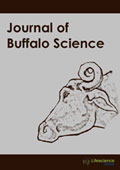jbs
|
|
Abstract: One of the most important challenges facing today’s society is feeding a growing world population. This review aims to examine the available information to assess the potential of river buffalo as a meat producer with a focus on the sustainability of the supply chain and on meat quality in terms of nutritional and sensory properties. Traditionally, buffalo meat came from old, culled animals in rural agricultural regions where animals were slaughtered at the end of their productive life as dairy or draught animals. Therefore, the meat had low quality. However, when younger animals are used, buffalo meat is generally well appreciated by consumers. Buffaloes can adapt to different production systems and convert poor-quality high fiber feedstuffs into high-quality products, including meat, with a lower degree of competition with human nutrition. In addition, although requiring more land, extensive production systems may have lower environmental impacts due to the low inputs used in the productive process and show higher levels of animal welfare. Although weight gains and dressing percentages are generally lower than in cattle, the meat is characterized by better nutritional properties (low fat and cholesterol contents, high-quality protein, and unsaturated fatty acids). In addition, the use of appropriate production systems might improve its sensory properties. Therefore, buffalo meat may be considered a good option to meet the increasing demand for food for human consumption. Keywords: River buffalo, meat, rearing systems, sustainability, performance, nutritional quality, sensory properties. |
|
|
Abstract: The paper describes for the first time four cases of postparturient malignant edema in water buffaloes due to Clostridium septicum (Cl. septicum). The study was carried out on four primiparous buffaloes that showed swelling of perineal and perivulvar areas, fever and agalactia a few hours after calving. Two of them died within 20 hours after calving. The other two developed edema in the skeletal muscles of one leg and were treated with sulfadiazine-trimethoprim for 10 days. The clinical signs completely resolved. Culture and molecular investigations identified the pathogen isolated from exudate taken from the vulva as Cl. septicum. The isolate showed multi-drug resistance. In the management of infection due to Cl. septicum, timely diagnosis and the chirurgic curettage, associated with a broad-spectrum antibiotic therapy, were found to be sufficient for the survival and recovery of the infected animals. Keywords: Antibiogram, buffaloes (Bubalus bubalis), Clostridium septicum, malignant edema. |
|
|
Abstract: Dairy products are an essential source of animal protein, particularly for nutritional vulnerable groups and vegetarians in Asian countries. Therefore, the approach towards increasing the domestic supply of milk is to raise the buffalo milk yield via genetic improvement from the semen of the selected buffalo sire that possesses a high predicted milk difference. Data were collected from Artificial Insemination Centers in Egypt, as a case study, to apply a dynamic mathematical investment model for estimating the rate of return (IRR) to genetic investment. The effective variables in IRR, besides the economic variables, are the reproductive traits and feed efficiency. The estimated most probable level of IRR was feasible, i.e., 19.71%. A worse change in the reproductive efficiency variables, i.e., the aggregate of 10% increase in the number of conception services, age at the First Calving, and the service period, would decrease the IRR by 7.51%. A decrease in feed efficiency by 10% would decrease the IRR by 9%. A worse change by 10% in the feed costs, price of semen, and milk price would decrease IRR by 7%. To import buffalo sires' semen of high predicted milk difference at moderate prices till establishment, domestic genetic merit is required. Keywords: Dairy buffalo, Feeds, Genetic improving, Investment model, Reproductive traits. |
|
|
Abstract: This research work was carried out to compare the various physicochemical parameters of two species, camel and buffalo. Camel milk samples were collected at National Research Centre on Camel, Bikaner and buffaloes milk samples were collected from the surroundings villages of Bikaner. After collection milk samples were brought to the laboratory of NRCC Bikaner and they were analyzed for fat, SNF (Solid Not Fat), protein, lactose, total ash and pH using milk analyzer (Lactoscan). Camel milk had 2.71±0.11 fat, 6.91±0.03 SNF, 2.23±0.02 protein, 3.86±0.02 lactose, 0.79±0.004 total ash and 6.95±0.01 pH while buffalo milk had 8.71±0.82 fat, 8.44±0.19 SNF, 4.11±0.02 protein, 4.46±0.15 lactose, 0.98±0.05 total ash and 7.59±0.02 pH. Fat, SNF, protein and pH of buffalo milk was significantly (P<0.001) higher than camel milk. Lactose and total ash in buffalo milk was also higher than camel milk but at P<0.05 level. So it can be concluded that all the studied parameters were high in buffalo milk than camel milk. Keywords: Fat, SNF, Protein, Lactose and Milk Analyzer.Download Full Article |
|
|
Abstract: The aim of this study was to investigate the enzymatic activity of 21 bacteria isolated from refrigerated raw buffalo milk, as well as to evaluate the production of biofilm by these bacteria. Proteolytic, lipolytic and lecithinase activity, as well as the production of exopolysaccharides were evaluated at different temperatures. For all of the psychrotrophic bacteria, biofilm formation on microtiter plates was evaluated at different temperatures and in the presence of residual buffalo and bovine milk. All cultures showed a proteolytic profile while 9 cultures showed lipase activity. Lecithinase production was found in 7 of the evaluated psychrotrophic bacteria. The ability to produce exopolysaccharides was found in 12 bacteria. Of the 21 bacterial isolates, 16 were biofilm producers at 7°C. At 23°C, 20 isolates were found to be biofilm producers. At a temperature of 37°C, biofilm formation by 17 isolates was weak. In the presence of residual buffalo milk, 7 were biofilm producers, while 16 bacteria produced biofilm in residual bovine milk. The results of this study show that many isolates of psychrotrophic bacteria from raw buffalo milk have the potential to produce extracellular enzymes as well as biofilm. This deserves special attention when considering the best practices to recommend during the collection of raw milk in establishments which process milk. Keywords: Psychrotrophic bacteria, proteolysis, lipolysis, adhesion, milk. |


